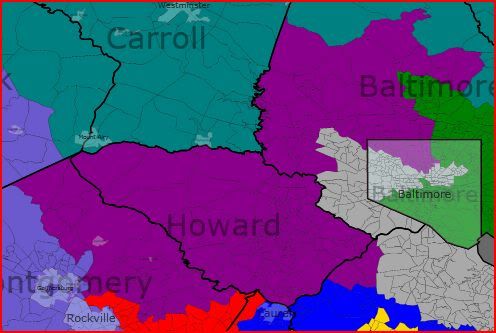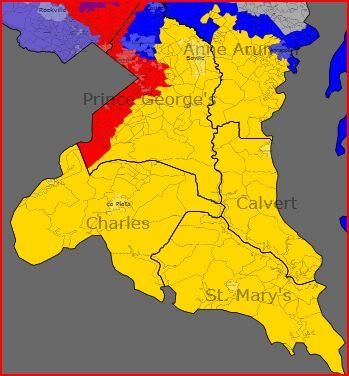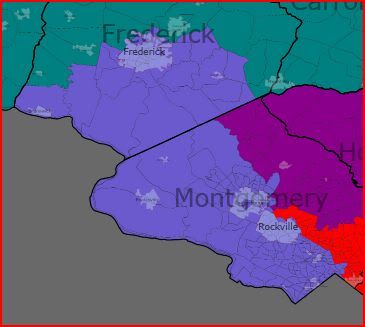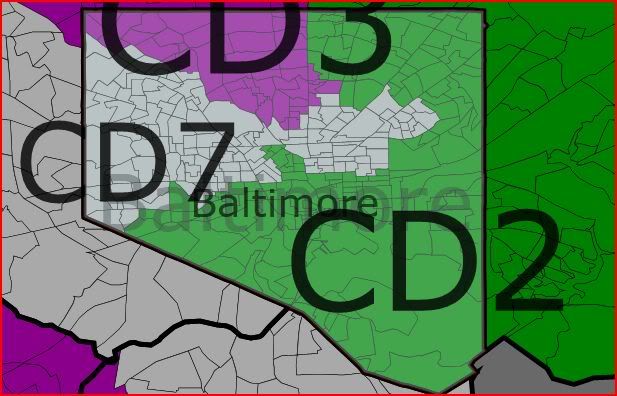Although the people of Hawaii would beg to differ with my characterization (their turn is Saturday), this is the last big night of primaries for the cycle.
• DE-Sen (R): Mike Castle would unquestionably be the strongest candidate the GOP could put up for the seat being vacated by appointed placeholder Ted Kaufman, but since when has that stopped the GOP? Castle is facing a surging teabagger, Christine O’Donnell, who’s received plenty of assistance from the Tea Party Express (or as James Hell would say, a quarter million dead presidents worth) and the Grizzly Momma herself. O’Donnell has plenty of baggage from her run against Joe Biden in 2008, but yesterday’s PPP poll has cat fud lovers salivating, showing a narrow 47-44 advantage for none other than O’Donnell. We can’t help but pull for an O’Donnell victory, which would singlehandedly tilt this race significantly in Team Blue’s favor. (JMD)
• DE-AL (R): True SSPers will never pass up a race that has high egg-on-NRCC’s-face potential (or EoNRCCFP, if you will), something we might very well find here tonight. Two businesspeople – Michele Rollins and Glen Urquhart – face off, though Rollins has the backing of the state GOP; she’s technically more moderate than the full-fleged ‘bagger Urquhart. Urquhart had a 12-point lead in the last PPP poll of the race (which, of course, also indicated a very conservative primary electorate inclined to chuck Mike Castle). Both are on the air, and have had the requisite funds with which to do so ($433k spent by Rollins, $514k by Urquhart). It’s hard to decide who to root for here – let’s keep our mojo for the race one up on the ballot. (JMD)
• DC-Mayor (D): Incumbent Adrian Fenty hasn’t been afraid to enact controversial policies since taking office in 2007. Most notable has been his support for his controversial Chancellor of Schools appointment, Michelle Rhee. Fenty’s unpopularity has been seized by City Council Chairman Vincent Gray, opening up a divide between the newer transplants and long-time residents, who seem to prefer Fenty and Gray, respectively. The Washington Post has endorsed Fenty, as has the more local Washington City Paper …which took the opportunity to call Fenty “the jerk that D.C. needs.” Regardless, Gray has led in recent polling, with leads ranging from 7 points in a Clarus poll to 17 points in a recent WaPo poll. Given that, Gray should be favored tonight; it goes without saying that tonight’s winner will be the prohibitive favorite in this overwhelmingly Democratic city. (JMD)
• MA-09 (D): Labor activist Mac D’Alessandro has run an aggressive campaign against conservative Dem Stephen Lynch, who earned lifetime douchebag status by infamously switching from “yes” to “no” on the healthcare reform bill, in this South Boston-based district. D’Alessandro has enjoyed $250K in expenditures on his behalf from the SEIU (his former organization), and benefited from a late surge in campaign funds, but has still been badly out-raised by Lynch. (JL)
• MA-10 (D/R): Fortunately, the Dem primary to replace outgoing Dem Rep. Bill Delahunt has been relatively calm. State Sen. Robert O’Leary and Norfolk DA William Keating are the players here, but it’s been hard to get a read on who has the upper hand. O’Leary released an internal poll in early August claiming a 6-point lead, while Keating enjoyed some late-breaking positive press from chasing down a purse snatcher over the weekend. Your guess is as good as mine!
Republicans hope to seriously contest this seat in November, but both their candidates – state Rep. Jeff Perry and ex-Treasurer Joe Malone – have significant baggage: Malone for several of his staffers stealing nearly $10 million from the Treasurer’s office under his watch in the ’90s, and Perry for his oversight of a police officer under his command who conducted illegal strip-searches of teenage girls while Perry was a police sergeant in the early 1990s. (JL)
• MD-Gov (R): Former Governor Robert Ehrlich – who spent four years in office constantly clashing with the Democratic-controlled state legislature before his defeat by then Baltimore Mayor Martin O’Malley – is attempting a comeback. He faces a primary challenger from the Palin-endorsed businessman, Brian Murphy. Unlike Joe Miller in Alaska or Christine O’Donnell in Delaware, Murphy’s continued to struggle in the fundraising department, and the Tea Party Express has yet to come bail him out. Palin’s endorsement, however, has allowed Ehrlich to portray himself as – shockingly – a moderate, something he was far from while in office. Ehrlich’s expected to win, but a weak showing could presage some conservative discontent with him…which may bode well for O’Malley in November. (JMD)
• MD-01 (R): Suburban Baltimore state Senator Andy Harris – who teabagged then-Rep. Wayne Gilchrist before teabagging was popular and who we can thank for incumbent Dem. Frank Kratovil – is back for a rematch, but only if he can get past self-funding businessman Rob Fisher. The traditional divides are here again, with Harris being from NOT the Eastern Shore and Fisher being from the one area that could qualify as a population center, Salisbury. Neither candidate has been short on resources, with Harris having spent $664k and Fisher having spent $425k. Gilchrist, one of the last moderate GOPers in the House, has gone ahead and endorsed Fisher; Kratovil, of course, would prefer to face the poor ideological and geographic fit that is Harris. (JMD)
• MD-04 (D): Incumbent Donna Edwards did us all a huge favor by ridding us of the incredibly douchey Albert Wynn in the primary in 2008 – Wynn soon proved his douchebaggery by taking his marbles and going home early, forcing the state of Maryland to outlay for a special election. Soon after Edwards took office though, various state and local officials began rumblings about a primary challenge, usually with some variation on her being too liberal …for an 85% Obama district. The only one who ultimately took the plunge was State Delegate Herman Taylor, who represents a section of upcounty Montgomery. It’s unclear how much traction Taylor’s been able to get, but his measly $60k raised total isn’t the best sign for him. Two other perennial candidates round out this field. (JMD)
• NH-Sen (R): For a while, it looked like New Hampshire AG Kelly Ayotte’s chief competition would come from her left in the form of pro-choice businessman Bill Binnie. However, judging by the most recent polls, Binnie’s failure to gain any traction proves that running as a moderate within the modern Republican party is, in the words of one Edward M. Rooney, buying yourself a first-class ticket to nowhere. Instead, Ayotte appears to be subject to a credible late surge by the superbly-named attorney Ovide Lamontagne. Lamontagne is a favorite of movement conservatives but one who failed to attract the support of the scalp-collecting insurgents at the Tea Party Express. The two most recent polls have shown Ovide making a dramatic late run, but still coming up a few points short: Magellan has Ayotte up by 4, while PPP gave Ayotte a 7-point lead. National movement support never quite gelled consistently for Lamontagne, as he could only muster the backing of Laura Ingraham to match Sarah Palin’s full-throated Ayotte endorsement. Lamontagne is no stranger to upsets, though – he famously rocked the establishment in 1996 by winning the gubernatorial nomination that year. (JL)
• NH-01 (R): Manchester Mayor Frank Guinta, the early front-runner for the GOP nod to take on sophomore Dem Rep. Carol Shea-Porter, stumbled out of the gate with tepid early fundraising and reports of a bar fight dogging him in the press. A bunch of rich businessman sensed an opportunity and jumped into the ring, including Richard Ashooh, Bob Bestani, and Sean Mahoney. Mahoney, who’s pumped $900K of his own money into the race, seems to be the candidate to watch (the New Hampshire Democratic Party has even put out negative mailers against him). Guinta’s been dogged by even more bad press lately (including criticism from ex-Rep. Jeb Bradley over some weird financial irregularities), but it might be a mistake to count the teabaggish mayor out. (JL)
• NH-02 (D/R): Progressive fave Ann McLane Kuster is kicking ass in money and polls over the Joe Lieberman-associated Katrina Swett for the Dem nod to replace Paul Hodes in the House. For the GOP, ex-Rep. Charlie Bass appears in control against radio personality and proto-teabagger Jen Horn (whom Hodes clobbered in 2008), though Bass actually felt compelled to hit the airwaves earlier this month. A Horn upset here is probably be too much to hope for, but one can always dream. (JL)
• NY-Sen (R): Despite recruitment efforts by everyone from Karl Rove to Michael Bloomberg, the trio of contenders who emerged to challenge appointed Sen. Kirsten Gillibrand is decidedly lacking in stature. The state GOP put two men on the ballot at their convention: David Malpass, a former Reagan and Bush I advisor – and also the (clearly former) Chief Economist at Bear Stearns, and Bruce Blakeman, a one-time Port Authority commissioner (i.e., friend of George Pataki’s) and failed candidate for Comptroller in 1998. But as irony would have it, the one guy who had to petition to get on the ballot, two-term Westchester ex-Rep. Joe DioGuardi (and father of former American Idol judge Kara), has consistently led in the polls. At least half of the electorate was still undecided even in the most recent surveys, though, so this race is potentially up for grabs. Malpass has spent $2.5 million of his own money, so he’s probably the biggest threat to DioGuardi, who’s tossed in a million.
BTW, believe it or not, but there’s also a Republican primary for the privilege of taking on Chuck Schumer, too. Political consultant Jay Townsend has had narrow leads (with tons undecided) over former CIA officer Gary Bernsten. (D)
• NY-Gov (R): The most-touted Republican to enter the New York gubernatorial race wasn’t even a Republican – and that was the problem. The state GOP managed to recruit obnoxious anti-immigrant Suffolk County Executive Steve Levy, but Levy couldn’t formally complete a party switch in time, and failed to meet a special 50% threshold (normally it takes just 25%) to get on the ballot at the Republican convention. That left the GOP with ex-Rep. (and 2000 Hillary Clinton victim) Rick Lazio, who presumably thought he could sleepwalk his way to the nomination. But wealthy businessman Carl Paladino – one of the most revolting human beings alive today in the Empire State (click here – NSFW) – jumped into the game, spending at least $2.5 million so far and claiming he’d spend four times that. Polling has showed Paladino gaining on Lazio, and the most recent survey (by Siena – PDF) actually had them tied in the low 40s. The winner gets to take on AG Andrew Cuomo and his (at least) $24 million warchest. (D)
• NY-01 (R): What a hot mess. The GOP looked like it scored a strong recruit in wealthy businessman (what else is new?) Randy Altschuler, who has spent $2 million of his own money to date. He’s had to spend so much so early, though, because he most definitely did not clear the field. Former SEC prosecutor George Demos also entered the race, and has raised half a million bucks. That might ordinarily seem respectable, except for the fact that another guy also got in: Chris Cox, grandson of none other than Dick Nixon and son of the state party chair, Ed Cox. Cox has self-funded a million bucks so far, and boy has this three-way gotten nasty. The round-robin of attacks is too extensive to elucidate here, but rest assured that the CFQ (Cat Fud Quotient) is high indeed. Altschuler previously snagged the Conservative Party ballot line, so Rep. Tim Bishop (who has already benefitted from the flying fur) could catch a real break if Cox (or Demos) pulled out the GOP nod. (D)
• NY-10 (D): Ed Towns is a bad congressman. Ed Towns should not be in Congress. Ed Towns, sadly, is very likely to stay in Congress. He’s facing a rematch from former Real World star Kevin Powell, a weak candidate with baggage of his own who hasn’t raised much and got killed in 2008. Towns has taken no chances, though, once again spending well over a million bucks on his re-election campaign. (D)
• NY-13 (R): I’ll be honest – Staten Island Republican shenanigans baffle the fuck out of me. For reasons that have never been clear to me, they settled on lawyer Michael Allegretti as their preferred candidate (well, after trying to nominate disgraced ex-Rep. Vito Fossella for his old seat) – who also owns a share of the family business, Bayside Fuel and Oil, which just happened to employ a longtime Gambino family lieutenant back in the day. Most amusingly of all, Allegretti’s opponent Mike Grimm served on the FBI squad which was responsible for investigating the mob in the 90s – including the Bayside Fuel deal. Grimm’s profile (9/11 first responder) helped endear him to national Republican figures like Rudy Giuliani and John McCain, while the locals pretty much all cottoned to Allegretti. The race has been fiercely negative, with Grimm securing the Conservative Party line and Allegretti attacking Grimm for apparently not having a job – and for never having voted in a GOP primary. (D)
• NY-14 (D): Hedge fund attorney and Hillary Clinton fundraiser Reshma Saujani appeared out of nowhere earlier this year to challenge Rep. Carolyn Maloney, a congresswoman whose record few had ever complained about. Saujani has pulled in an impressive $1.4 million, largely drawing on Wall Street and the Indian-American community. Maloney, though, has outspent her challenger almost two-to-one and still has $2 million on hand, about ten times what Saujani has left in the bank. Saujani has been most notable for her desire to be kinder to the financial titans who ruined our economy – a message which perhaps might resonate in the pre-war buildings along Park and Fifth Avenues. But the 14th District, which stretches from the Lower East Side to Astoria in Queens, is more diverse than you might think. With any luck, Saujani, who has run a nasty campaign, will get crushed and slink away, though she’s already promised to run again in 2012 if she loses. However, we haven’t seen any polls since a long-ago Maloney internal (which showed her crushing). (D)
• NY-15 (D): Trillion-term Rep. Charlie Rangel, the Warhorse of Ways & Means, has been laid very, very low by a slew of ethical misconduct allegations over the last few years, culminating in formal charges by the House Ethics Committee earlier this summer. For the most part, though, the political establishment has either stuck with Rangel or avoided taking sides, so his only primary opposition is fairly weak-sauce – and divided. Arrayed against Rangel are former aide Vincent Morgan, Assemblyman Adam Clayton Powell IV, and activist Jonathan Tasini. None have raised much money, and the most prominent among them, Powell, not only has some baggage but also got crushed in a prior primary challenge against Rangel back in 1994. Despite the quality of the field, Rangel has managed to spend $3.5 million out of his campaign account this cycle – though half of that has been on legal fees. (D)
• NY-23 (R): Another race with a tremendous Cat Fud Quotient. Teabaggers still love them some Doug Hoffman, who blew the special election against Rep. Bill Owens last November. But the creepy Hoffman has raised poorly since the special and has just $150K left. Meanwhile, Republicans eager for a fresh start have rallied around investment banker Matt Doheny, who has given his campaign $1 million and raised another $850K. The good news is that Hoffman has once again secured the Conservative line, while Doheny has scored a spot on the Independence Party ticket. So no matter what happens in the GOP primary (which, predictably, has been pretty negative), there will be a right-wing split in November for the second time in a row. The only poll of this race was a Hoffman internal from July showing him up by about thirty points. Still, I’m a little skeptical, as Hoffman’s surge last year was powered by a lot of outside money, which he hasn’t seen this time around. So this may well be anybody’s race. (D)
• NY-AG (D): Around a decade ago, a guy named Eliot Spitzer (whom you might know as an up-and-coming CNN talking head) started transforming the New York Attorney General’s Office into a serious activist powerhouse, investigating and pressuring all manner of corporate miscreants. While current AG Andrew Cuomo’s public approach has differed from his predecessor’s, he’s continued the pattern of going after big fish – and, like Spitzer before him, he’s using the post to seek the governor’s mansion, so this unusually potent state office is one worth keeping an eye one. The apparent front-runner is state Sen. Eric Schneiderman, who has racked up a broad array of establishment support – and consequently faced a pile-on by his opponents at a recent debate. His closest rival is probably Nassau County DA Kathleen Rice, a law-n-order suburban conservative who never voted until age 37 (in 2002). Rounding out the field are Assemblyman Richard Brodsky of Westchester, former state Insurance Commissioner Eric Dinallo, and former federal prosecutor and wealthy trial attorney Sean Coffey. The winner will face Staten Island DA Dan Donovan in the fall. (D)
• RI-01 (D): House seats in blue Rhode Island can be a lifetime sinecure if so desired, so in the rare instances they’re open, expect a free-for-all to get in. When Patrick Kennedy announced his retirement, Providence mayor David Cicilline (who’d previously declined a widely-expected gubernatorial bid) jumped in and quickly dominated the fundraising scene. A month-old Brown University poll shows former state party chair William Lynch as his closest competition, with Cicilline up 32-15. However, the race’s third wheel, wealthy businessman Anthony Gemma has hit Cicilline hard with a very negative TV blitz, while the race’s fourth wheel, state Rep. David Segal, is relying on a grassroots push from unions, so they may be in stronger position now than when that poll was taken. The winner faces Republican state Rep. John Loughlin, who faces a steep climb in this D+13 district but can exploit the harsh Dem primary as well having an open seat in this kind of climate. If Cicilline wins, he’ll be the third openly-LGBT member of Congress. (C)
• RI-02 (D): Sometimes a House seat in Rhode Island is so tempting that a Dem has to go for it even when it it’s not open. That’s what former state Rep. Betsy Dennigan is doing, challenging entrenched Rep. Jim Langevin. In an interesting choice, Dennigan isn’t making any hay out of the abortion issue, which was at issue in several other previous primary challenges to the pro-life Langevin, who hews to the party line on most other issues. Without that on the table, don’t expect much fireworks here: the month-old Brown University poll finds Langevin leading 55-12. (C)
• WI-Sen (R): Ron Johnson, wealthy owner of a plastics manufacturing concern thanks to a fair amount of help from that government he hates so much, is that rare breed of Republican: one who’s both the establishment’s preferred choice (after Tommy Thompson didn’t get in, they decided to go the self-funder route) and the fave of the teabaggers (complete with Jim DeMint’s seal of approval). Johnson has been spending heavily on advertising (although with an eye toward the general), so there’s likely to be little drama here: the only recent poll of the race comes from PPP in early July, who found Johnson leading little-known Dave Westlake 49-11. Businessman Terence Wall, who’d been Johnson’s main rival until he dropped out in a huff after the state convention, has made some noises about a late-breaking write-in bid, but is unlikely to be much of a factor either. (C)
• WI-Gov (R): This was initially touted as a bout between two local Republican heavyweights (or at least welterweights): Milwaukee Co. Executive Scott Walker, and ex-Rep. Mark Neumann, attempting a return to politics after losing a close 1998 Senate election to Russ Feingold. Neumann has the added advantage of being a wealthy real estate developer, but for whatever reason — probably the “who’s that?” factor that sets in after twelve years out of the spotlight — Neumann hasn’t gotten much traction. The most recent poll, from PPP in early July, gave Walker (head of the state’s most populous county) a 58-19 edge. Certain Dem nominee Tom Barrett has usually polled better against Neumann than Walker, so there’s somebody to root for. (C)
• WI-07 (R): Everyone assumes that hunky Ashland County DA/ex-reality star/ex-timber sports competitor Sean Duffy is well on his way to facing off against Democratic state Sen. Julie Lassa for the open seat left behind by David Obey in this D+3 district. Not so fast, there… as Mr. GOP Establishment, he still has to run the gauntlet of the inevitable teabagger challenge. He faces off against Obey’s 2008 challenger, Dan Mielke. (C)
• WI-08 (R): For such a potentially consequential general election, we have surprisingly little intelligence about the GOP primary to pick someone to go up against vulnerable sophomore Rep. Steve Kagen. There seem to be at least five viable candidates here; the one who’s raised by far the most and that the NRCC seems to be favoring, though, is the one who’s never held elective office: contractor Reid Ribble. State Rep. Roger Roth may have an inherited name rec advantage (he’s related to the area’s former Rep., Toby Roth), and former state Rep. Terri McCormick seems to be the fave among the social conservatives, so either of them may well be in position to win as well. The field is rounded out by Door County Supervisor and NHL star Marc Savard, and Brown County Supervisor and 50s crooner Andy Williams. (C)
Closing times (all Eastern time):
NH – 7pm (8pm local option)
DE – 8pm
DC – 8pm
MD – 8pm
MA – 8pm
NY – 9pm
RI – 9pm
WI – 9pm













